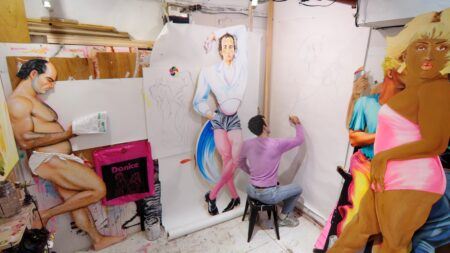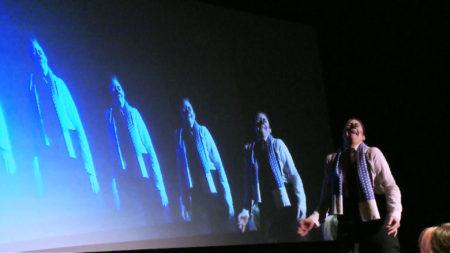Continue playing
(Time remaining: )
Play from beginning
Continue playing "{{ controller.videos[controller.getVideo(controller.currentVideo)].segmentParentTitle}}"
{{controller.videos[controller.getVideo(controller.currentVideo)].title}} has ended.
Liz Magic Laser's Guerrilla Theater
How can changing the context for a performance alter its meaning? In this film, artist Liz Magic Laser directs a group of actors performing theatrical scenes in public locations throughout New York City. “There’s a respect for the material but then there’s a complete disrespect for how they’re supposed to be done,” explains Laser, who describes her approach as “playing with the tension between script and context and somehow a mismatch between the two.”
For Laser’s performance chase (2009-10), Bertolt Brecht‘s play Man Equals Man (1926)—an allegory of capitalist greed and militarism—is staged in public bank vestibules throughout New York City in the aftermath of the 2007–08 financial crisis. Laser worked with each actor individually, rehearsing and filming scenes one-on-one, and later edited the footage together to reconstitute the play’s plot and dialogue. Improvising in each location, actors also deliver dialogue to unsuspecting customers, bank signage, and ATMs.
“It was like playing a practical joke on someone over and over, but there was never a punch line,” says Laser, who was frequently kicked out of the banks during filming only to move to a vestibule on the next block. For Laser’s Flight (2011), the artist choreographed six actors performing staircase-based chase scenes from 23 films on the Times Square TKTS booth bleachers. Tracing the history of trauma in cinema—in films such as M (1931), The French Connection (1971), The Shining (1980), and A History of Violence (2005)—the performance is conceived as a 30-minute climactic moment, with actors quickly switching roles from victim to villain throughout.
“We’re rehearsing for emotions through this material constantly,” says Laser, “It doesn’t matter that we know it’s fake. It still has a pretty intense impact on us psychologically.” Performed amidst a live audience, Flight invites viewers to shift from passive witnesses to active participants, interrupting violent acts in a way that’s impossible to do at the movies.
Featuring additional commentary from the actors Nic Grelli, Michael Wiener, Lia Woertendyke, and Max Woertendyke.
More information and creditsCredits
Art21 New York Close Up Created & Produced by: Wesley Miller & Nick Ravich. Editor: Brad Kimbrough. Cinematography: Don Edler, Nicholas Lindner, John Marton, and Andrew David Watson. Sound: Scott Fernjack. Associate Producer: Ian Forster. Production Assistant: Amanda Long and Tida Tippapart. Design & Graphics: Crux Studio and Open. Artwork: Liz Magic Laser. Additional Camera & Sound: David Guinan, Collin Kornfeind, Liz Magic Laser, Kenny Lewis, Boman Modine, Polemic Media, Tim Wagner, and Eric Yoon. Thanks: Annika Boras, Audrey Crabtree, Cori Kresge, Andra Eggleston, Alan Good, Nic Grelli, Elizabeth Hodur, Gary Lai, Liz Micek, Justin Sayre, Doug Walter, Michael Wiener, Lia Woertendyke, Max Woertendyke, and Cat Yezbak. An Art21 Workshop Production. © Art21, Inc. 2013. All rights reserved.
Closed captionsAvailable in English, German, Romanian, Italian, Japanese, Korean, Chinese, Italian
Through the Art21 Translation Project, multilingual audiences from around the globe can contribute translations, making Art21 films more accessible worldwide.
Interested in showing this film in an exhibition or public screening? To license this video please visit Licensing & Reproduction.
Liz Magic Laser was born in 1981 in New York, where she lives and works. Laser’s practice includes video and performance as well as sculpture and installation. Dissecting ideas of power and how it is performed, Laser has worked with such forms as presidential speeches, TED Talks, and nightly news broadcasts. She often integrates audience participation into works that involve social and political critiques, and has staged performances in public spaces such as banks and movie theaters. More recently, Laser has expanded her interest in the construction of identities to include children and the ways in which their self-perception is influenced by the news media.
Trailer



